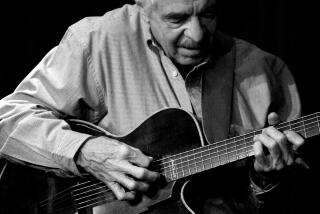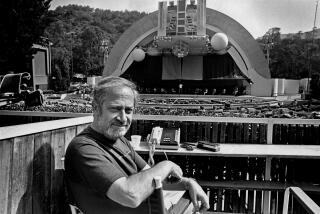JAZZ REVIEW : Cavanaugh: A Page of Musical History
- Share via
COSTA MESA — Page Cavanaugh is a national treasure, a veritable compendium of American songs and piano styles. If you don’t believe it, ask two of Cavanaugh’s biggest fans, Michael Feinstein and Liza Minnelli, both of whom came into his regular engagement at J. P.’s Money Tree in Toluca Lake on Friday to perform with their hero.
Saturday, Cavanaugh was at the Fine Arts Recital Hall on the Orange Coast College campus, without Feinstein and Minnelli. But who needed them? Along with longtime collaborator, guitarist Al Viola, and bassist Richard Simon, Cavanaugh put on a nearly two-hour show that was satisfyingly musical as well as nostalgic.
The trio showed its mettle on the opener, “They Can’t Take That Away From Me,” played at an up-tempo pace with a bit of be-bop feel. Cavanaugh’s improvisation contained touches of stride and boogie-woogie, while alluding to Art Tatum, Bud Powell and Nat Cole at the piano. He dropped in a line from “Back Home Again in Indiana,” a tune he played as a ballad later in the show. Viola added nimble lines and chordal echoes while Simon walked at a breathtaking pace.
The evening was a special showcase for Viola. The guitarist, who first started playing with Cavanaugh some 50 years ago, seemed particularly attuned to the pianist’s style, adding a rhythmic pulse sprinkled with accenting lines and embellishments behind Cavanaugh’s vocals. Left to his own devices, Viola improvised with aplomb, stringing together long, lyrical lines balanced with frequent clusters of emphatic chords.
Simon, filling in for Cavanaugh’s usual bassist, Phil Mallory, was able to run with Cavanaugh no matter what the pace. His strong, accurately pitched foundation gave the singer a wide surface on which to work his rhythmic twists. The bassist was particularly strong during a fast-paced version of Billy Strayhorn’s “Take the A Train.”
Cavanaugh used a playful way with lyrics to spruce up even the most familiar tune, sometimes lagging behind the beat, sometimes compressing two phrases into the space of one. He messed with the words of “Route 66,” leaving some out here, adding others there. He completely changed “It’s Magic” with words appropriate to his rewrite: “It’s Tragic.”
Though his voice has a tendency to be unsteady during sustained tones, he made his most sensitive vocal statement on his own tune, “Whatever Happened to Me,” a considered ballad that provides a glimpse into his up-and-down career.
He acknowledged his friend Feinstein (who’s done a lot to rejuvenate Cavanaugh’s career) by doing his younger colleague’s “Half of April, Most of May,” a ballad about a six-week love affair.
Nat Cole was recalled a number of times, not only with “Route 66” (written by Bobby Troup, another composer Cavanaugh honored), but also with “Sweet Lorraine” and “Walkin’ My Baby Back Home,” which Cavanaugh claimed he covered before Cole had a hit with it.
A good measure of this show’s success was due to Cavanaugh’s between-tune patter, bringing the kind of intimacy to the recital hall more common to watering holes such as the Money Tree. Not only were Cavanaugh’s comments and asides entertaining, they were educational, sketching in the pianist’s career as he explained his ties to different tunes. He’s the kind of guy you could spend many evenings listening to. And you’d learn a lot about the American songbook.
The concert was scheduled to repeat Sunday afternoon.
More to Read
The biggest entertainment stories
Get our big stories about Hollywood, film, television, music, arts, culture and more right in your inbox as soon as they publish.
You may occasionally receive promotional content from the Los Angeles Times.










